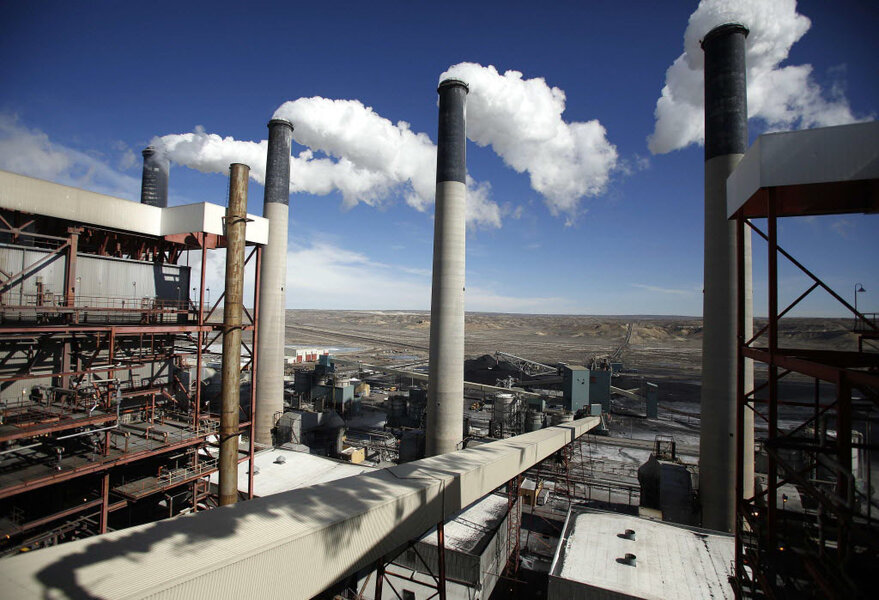Fuel from CO2? Experiment brings it a step closer to reality
Loading...
A YouTube video recently posted by the University of Central Florida shows a glass vial dangling inside a coiled blue LED light string. When researchers pump carbon dioxide into the tube, the molecules get trapped in a newly developed, honeycomb-like titanium compound. The blue light triggers a chemical reaction, and out bubbles formic acid.
“Carbon dioxide was photochemically reacted to produce a molecule that has higher energy content,” chemical engineer Michael Strano, who was not involved in this research, tells The Christian Science Monitor over the phone. In other words, the team took light and CO2, and turned out something more potent.
The UCF scientist who led the way to this accomplishment, assistant professor of chemistry Fernando Uribe-Romo, says that this research could yield major benefits. “We're trying to reach a higher[-energy] form of carbon,” he explains in a separate interview with the Monitor. When power plants emit planet-warming CO2, “you can recycle it back and use it as a real fuel.”
Much remains to be done before that vision becomes reality. While this experiment, described earlier this month in Journal of Materials Chemistry A, won’t immediately solve our energy woes, it does increase our control over light-induced chemical reactions.
Professor Strano, who serves as the Massachusetts Institute of Technology’s Carbon P. Dubbs professor of chemical engineering, explains that these “photocatalytic reactions” could help put our greenhouse gas emissions to use. “Carbon dioxide's abundant in the atmosphere...,” he explains, “and there's a lot of interest in turning it into materials.”
Plants already do this with photosynthesis, harnessing sunlight to convert water and CO2 into oxygen and glucose. In recent decades, chemists have sought a similar goal with the creation of “solar fuels.”
“In a solar fuel,” Strano explains, “you basically conduct a chemical reaction driven by the sun to form a new molecule, which stores the energy in the molecule as a fuel.” Unlike juice from solar panels, this energy is ready to use on demand – not just when it’s sunny – and doesn’t slowly bleed out, as it does with batteries.
Making this concept reality hasn’t been easy. It requires a material called a photocatalyst that, when exposed to sunlight, spurs the forming and re-configuration of chemical bonds.
Existing photocatalysts can build CO2 into bigger, more energy-dense molecules when exposed to ultraviolet (UV) light, which has a shorter wavelength and more energy than visible light. But that means they’re only using a tiny fraction of the sun’s total radiation. According to Strano, “it's been a central goal in the area of photocatalysis to tune the photocatalyst into the visible” spectrum.
Previous efforts to this end have involved rare, expensive metals, like platinum. But Uribe-Romo and his colleagues opted for a cheaper one: titanium.
The metal’s oxides can form a honeycomb-like structure called a metal-organic framework (MOF) that's full of holes for CO2 molecules to diffuse through. By adding other types of molecules, called alkyl groups, to this lattice, they altered it in such a way that the “bandgap” – the energy threshold that electrons need to jump for a fuel-forming reaction to take place – was reduced.
With a high bandgap, Uribe-Romo explains, “you need high-energy light, like UV.” But the researchers’ MOF can make formic acid, which contains more energy than CO2, with regular blue light.
This innovation brings scientists closer to their “central goal” of harnessing the full range of visible light, which contains all the colors of the rainbow, to make fuel. “The results are really interesting,” Strano tells the Monitor after reviewing the team’s paper. “They solve a couple of important problems.”
In addition to needing less energy, the team’s MOF can churn out formic acid for 120 hours. “That's a pretty respectable time for testing the photocatalyst,” Strano says, adding that previously developed photocatalysts tend to degrade in such long-term testing, making them impractical for use in the field.
While this new material holds up longer, Strano cautions that “they're really far removed from where they ultimately want to go.” By tuning their MOC to blue light, the researchers only grazed the top of the visible spectrum, leaving lower-energy wavelengths, like red and yellow, out of reach. The setup also relies on intense LED light, rather than natural sunlight. During his interview, Strano calculated that they exposed their material to “about a thousand times more blue light than there is in the solar spectrum.”
And the final product, formic acid, can only replace some of coal and oil’s energy. “We are not recovering all the energy we have from a hydrocarbon,” Uribe-Romo acknowledges, “because we just have an intermediate chemical species,” with fewer bonds than sugars, gasoline, and other types of fuels.
“We're doing research in order to achieve higher states of carbon using these materials,” he continues, and make the process work across the visible spectrum. “Ideally, we want a material that can absorb all the wavelengths, from the violet to the red.”
While scientists can’t yet match plants’ seconds-long glucose production, or Earth’s ability to forge energy-rich fossil fuels over millions of years, Uribe-Romo expects that this new technology will provide more options for an energy-hungry, carbon-emitting world.
“Perhaps if we put it where [carbon] localized in high amounts, like in a power plant, we can ... have a carbon-neutral production of energy,” he suggests.
“We need to find many ways to fight climate change and global warming, and this is one of the contributions.”








